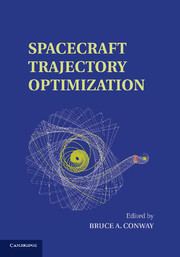Book contents
- Frontmatter
- Contents
- Preface
- 1 The Problem of Spacecraft Trajectory Optimization
- 2 Primer Vector Theory and Applications
- 3 Spacecraft Trajectory Optimization Using Direct Transcription and Nonlinear Programming
- 4 Elements of a Software System for Spacecraft Trajectory Optimization
- 5 Low-Thrust Trajectory Optimization Using Orbital Averaging and Control Parameterization
- 6 Analytic Representations of Optimal Low-Thrust Transfer in Circular Orbit
- 7 Global Optimization and Space Pruning for Spacecraft Trajectory Design
- 8 Incremental Techniques for Global Space Trajectory Design
- 9 Optimal Low-Thrust Trajectories Using Stable Manifolds
- 10 Swarming Theory Applied to Space Trajectory Optimization
- Index
- References
9 - Optimal Low-Thrust Trajectories Using Stable Manifolds
Published online by Cambridge University Press: 06 December 2010
- Frontmatter
- Contents
- Preface
- 1 The Problem of Spacecraft Trajectory Optimization
- 2 Primer Vector Theory and Applications
- 3 Spacecraft Trajectory Optimization Using Direct Transcription and Nonlinear Programming
- 4 Elements of a Software System for Spacecraft Trajectory Optimization
- 5 Low-Thrust Trajectory Optimization Using Orbital Averaging and Control Parameterization
- 6 Analytic Representations of Optimal Low-Thrust Transfer in Circular Orbit
- 7 Global Optimization and Space Pruning for Spacecraft Trajectory Design
- 8 Incremental Techniques for Global Space Trajectory Design
- 9 Optimal Low-Thrust Trajectories Using Stable Manifolds
- 10 Swarming Theory Applied to Space Trajectory Optimization
- Index
- References
Summary
Introduction
The three-body system has been of interest to mathematicians and scientists for well over a century dating back to Poincaré. Much of the interest in recent years has focused on using the interesting dynamics present around libration points to create trajectories that can travel vast distances around the solar system for almost no fuel expenditure traversing the so-called “Interplanetary Super Highway” (IPS). It has also been proposed to use Lagrange points as staging bases for more ambitious missions.
Lagrange points are equilibrium points of the three-body system that describes the motion of a massless particle in the presence of two massive primaries in a reference frame that rotates with the primaries. There are five Lagrange points (labeled L1,…,L5), the three collinear points along the line of the two primaries, and the two equilateral points that form an equilateral triangle with the two primaries. It is the collinear points that are of the most interest and in particular the L1 point between the two primaries and the L2 point on the far side of the smaller primary. Since Poincaré, there has been much work on finding periodic solutions to the three-body problem. Early work was confined to analytic studies that are restricted to approximations as there exists no closed form analytical solution to the three-body system equations of motion.
Information
- Type
- Chapter
- Information
- Spacecraft Trajectory Optimization , pp. 238 - 262Publisher: Cambridge University PressPrint publication year: 2010
References
Accessibility standard: Unknown
Why this information is here
This section outlines the accessibility features of this content - including support for screen readers, full keyboard navigation and high-contrast display options. This may not be relevant for you.Accessibility Information
- 15
- Cited by
